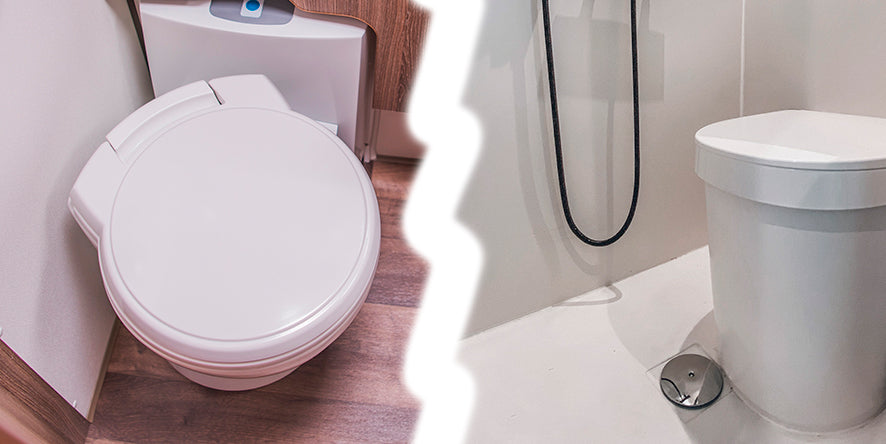Exploring the Ideal Toilet Solution for Your Caravan, RV, or Off-Grid Adventure
Are you tired of making frequent stops at questionable public restrooms during your caravan or RV journey? Have you grown weary of dealing with traditional RV toilets that often lack privacy and can emit unpleasant odors? Fortunately, there's a solution that empowers you to take charge of your restroom experience: portable toilets. These versatile sanitation solutions offer convenience and freedom, allowing you to answer nature's call wherever and whenever you please. But the question remains: which type of portable toilet is best suited for your caravan, RV, or off-grid lifestyle?
Making the switch from a conventional toilet to a portable option is a significant decision, one that involves careful consideration of various factors. How easy is it to clean? Will it provide the comfort you need? And most importantly, will it be odor-free? We understand the importance of making an informed choice, and that's why we've delved deep into the world of portable toilets to explore the qualities that set the best ones apart. In this comprehensive guide, we'll compare two popular options: the cassette toilet and the composting toilet.
Understanding the Difference: Cassette vs. Composting Toilet
Cassette toilets are reminiscent of traditional, stationary toilets found in vehicles. They feature an additional clean water tank that enables flushing, and some can even be permanently installed. However, the key distinction lies in the waste disposal process. In a connected RV toilet, waste is deposited into a concealed black water tank, out of sight and out of mind until you reach a dump station. In contrast, a cassette toilet has a compact, portable waste tank where both solids and liquids, along with chemicals, are mixed. This mixture must be manually emptied more frequently.
Composting toilets, on the other hand, are often referred to as dry toilets because they operate without water or chemicals for waste storage. Instead, they rely on a natural composting process that requires the separation of liquids from solids. As a result, composting toilets have two separate compartments that need periodic emptying, as opposed to the single, bulkier container in cassette toilets. Separett composting toilets have models specifically designed for RVs, vans, camping and boats.

Bulky cassette toilet container
Comparing Cassette and Composting Toilets for Caravan and RV Living
Now, let's delve deeper into the key differences between these two portable toilet options, with a focus on how they relate to your caravan, RV, or off-grid lifestyle:
1. Emptying the containers:
- Cassette toilets, which rely on water or chemicals in their tanks, fill up more quickly and require more frequent emptying. In most cases, this means emptying every other day, often necessitating a trip to designated dumping stations.
- Composting toilets offer a more extended disposal interval, typically requiring emptying every 4-14 days. Moreover, you won't be tied to specific disposal stations, as composting toilet waste doesn't contain chemicals. You can empty the liquids canister in any public toilet or sewage system and dispose of solids in a compost or disposal area following local guidelines. Separett composting toilets designed for cabins, house and Tiny homes have bigger containers providing a longer time in between emptyings.

Separett Villa container
2. Keeping the toilet tidy:
- Cassette toilets combine both liquid and solid waste in a single, large tank, making clean-up a potentially messy and unpleasant task. Emptying the tank can lead to splashing or spilling.
- Composting toilets begin the waste separation process from the start, resulting in a cleaner and more pleasant experience. The use of bag liners for solids simplifies disposal, similar to taking out the trash.
3. Impact to nature:
- Cassette toilets typically feature a holding tank capable of storing between 3 and 5 gallons of liquid. These tanks require chemical additives and frequent emptying, contributing to water waste and potentially overloading sewage treatment plants.
- Composting toilets are environmentally friendly, conserving water by eliminating its use in waste storage. Organic litter, toilet paper, and liner bags can be disposed of in composting areas, reducing your ecological footprint. Cleaning a composting toilet typically involves using natural vinegar or citrus concentrate diluted with water, avoiding harmful chemicals.

Cassette toilet is emptied to a collecting tank
4. Costs over time:
The following calculations are made with 2 people using the toilet on a daily basis.
- Cassette toilets often boast lower initial costs, with prices ranging from about $50 to $250. However, over time, the recurring expenses associated with chemical additives can add up significantly. A bottle of chemical additives cost about $10-12 for a 32 ounce bottle. A more environmentally friendly option will cost up to $22 for the same size bottle. A bottle is normally enough for 6-10 containerfulls depending on the size of the unit. $10-$22 for the chemicals cost $0.33-$0,73 per day.
- Composting toilets may have a higher upfront cost, typically ranging from $400 to $1,200. However, their long-term costs are more sustainable. On many models litter, vinegar concentrate, and composting bags are the primary expenses, resulting in lower overall costs in the long run. Separett composting toilets do not need sawdust or any other additives. The lack of sawdust in the solids container extends the emptying interval as no excess material is inserted to the container. The only running cost in addition to the little energy that's consumed is the bin liner bags. Separett compostable waste bags are extremely sturdy and they are specially made for compost toilet use unlike most of the other bags on the market that are standard household biowaste bags which should never be used in a composting toilet. The thin standard bags will start to decompose already in the toilet leading in leakage and bad odors sticking to the plastics of the toilet.
Separett Tiny compostable bags are sold in a roll of 10 bags for 12,9 $ (2024). Daily cost for the bags is 0,17 $ when the bucket is emptied once a week. Electricity to run the fan costs 0,007 $ per day with an average of 16,21 $ cost per kWh (2023). Total running cost for a Separett Tiny toilet is way below 0,2 $ per day.

Separett Tiny both models are neat and a view screen covers the solids container
The Ideal Choice for Caravan, RV, and Off-Grid Living
Both cassette toilets and composting toilets offer portability, allowing you the freedom to venture anywhere. However, when it comes to the specific needs of caravan, RV, and off-grid living enthusiasts, the composting toilet, such as our Separett Tiny, emerges as the superior choice. Despite the initial investment, the long-term advantages of a composting toilet, including cleanliness, ecological friendliness, and lower overall costs, make it a compelling choice for those who value comfort and convenience on their journeys.
The Separett Tiny, designed with the needs of caravan, RV, and off-grid living in mind, ensures a cleaner, greener, and more enjoyable toilet experience on the go. By choosing a composting toilet like the Separett Tiny, you not only enhance your comfort but also make a positive impact on the environment. Embrace the freedom of portable sanitation, and elevate your caravan, RV, or off-grid adventure with the Separett Tiny. Your journey begins here!

